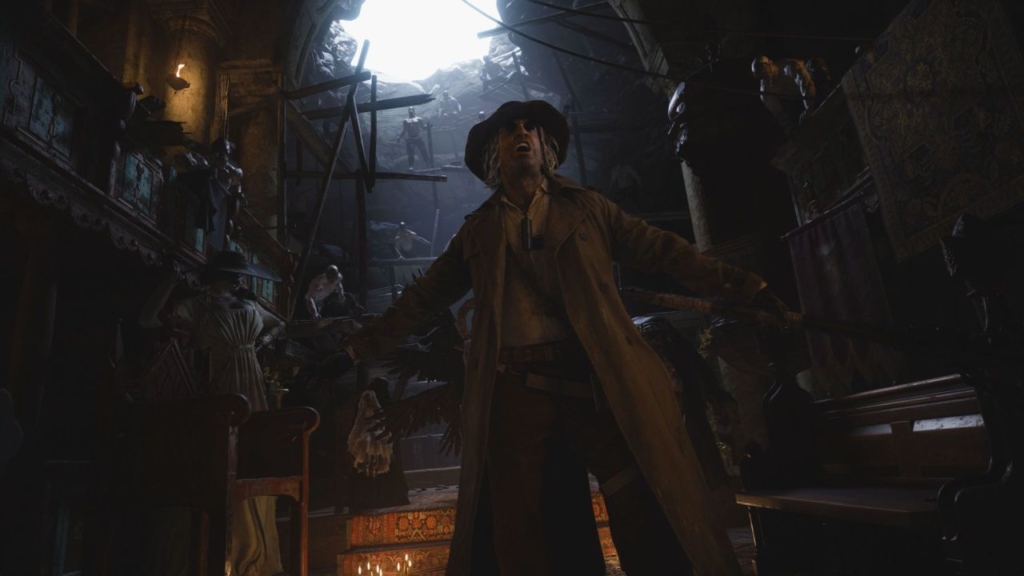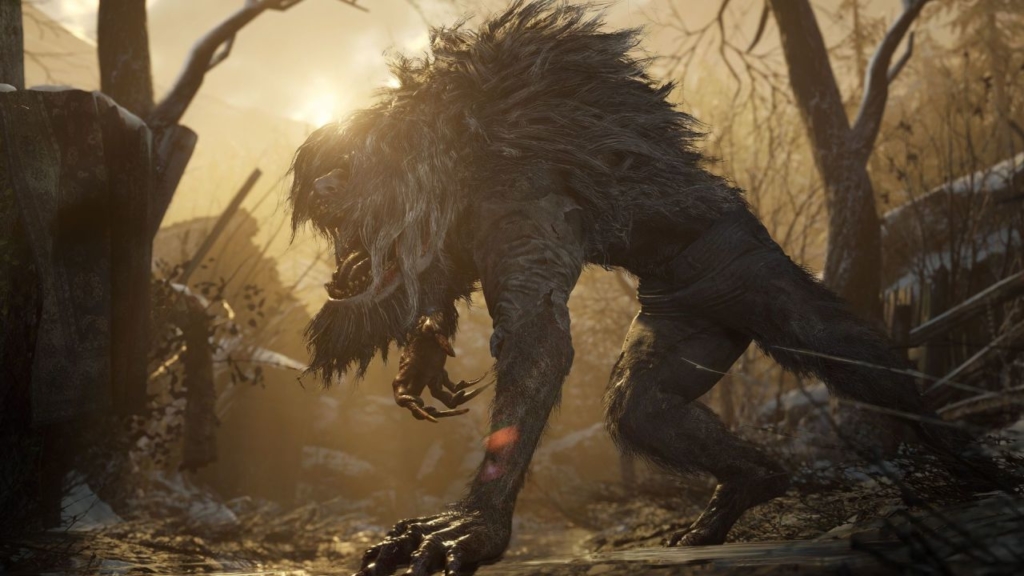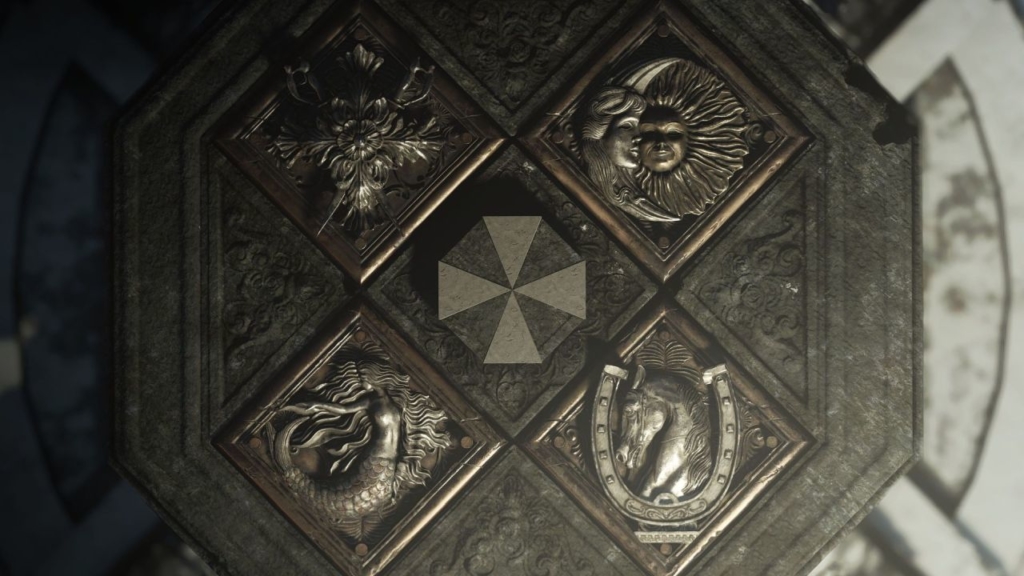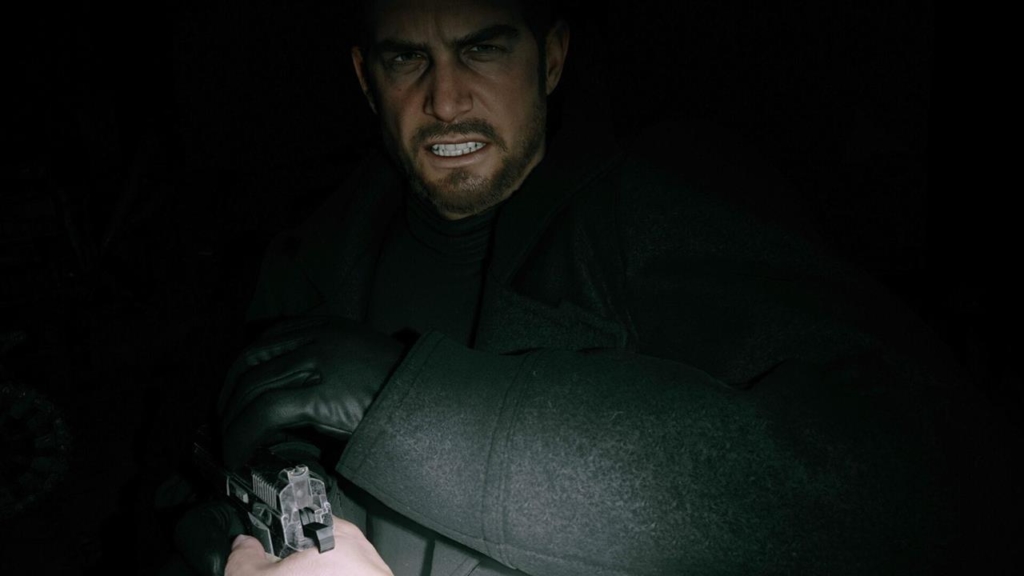
There’s a moment in Resident Evil: Village that instilled within me such a deep terror that I audibly shouted. I shouted so loudly, my cat sleeping behind me got such a fright that she fell off her scratching post and bolted out the room. It was a moment that reveals itself with little fanfare; there’s a prolonged segment of quiet puzzle solving before… “it” shows up and prowls around your location forcing you to run and hide.
I had to take a brisk walk to the kitchen and make myself a cup of tea. I don’t drink tea, but I needed something to calm the nerves. I’m saying this all upfront now because I want to emphasise that I video games don’t usually scare me like this. Not because I’m some kind of hardened tough manly man (not even slightly), but because I’ve played such a vast swathe of horror games over the years that they’ve all fused into one predictable formula for me. You learn their patterns and presentation, developing a sense of when to tense up and relax; there’s a rhythm to it. I played Resident Evil Village thinking that would be the case.
It was not. At all.
Resident Evil Village, if you’ve somehow missed the months of hype being poured into the game, is the direct sequel to Resident Evil 7 and the next mainline entry in the franchise. You’ll be playing as Ethan Winters three years after the worst day of his life, when he barely survived the utterly terrifying Baker family in Louisiana. Winters is just trying to enjoy his life again, move on from the horrors of his past and focus on his family in the European village they’ve been moved to, thanks to Chris Redfield trying to keep them out of trouble.
But this is a Resident Evil game. You and I both know that a happy ending was never on the cards.
Playing Resident Evil: Village feels like participating in a strange hybrid experiment. Based entirely on presentation, it’s Resident Evil 7’s first-person perspective, excessive gore and an emphasis on horror all rolled into one package. Yet once you get into the thick of things you’ll swear you’re playing Resident Evil 4. Entire sequences are seemingly lifted from Leon S. Kennedy’s trip into Europe from all those years back, with a continuation of mechanics that proceeding games dropped.
There’s the merchant who just shows up exactly when you need him to, upgradable weapons, an expandable inventory that serves as a puzzle in its own right, and more nods to the past. Yet the beauty of Village is taking the ideas of Resident Evil 4 and trimming the fat, replacing it with the classic Resident Evil flair that made the seventh game such a great reboot.
You’ll be shooting more things but you’ll also be exploring this labyrinth of a map, collecting various keys and items to unlock the way forward. Or backward in some cases. Even the tone of the game shifts rapidly between its two primary inspirations, jumping between quiet and isolated horror in dimly lit environments to sniping dragon-shaped bioweapons out of the sky atop an exploding castle. It’s enough to give the player whiplash at times.

Yet it all works beautifully. Resident Evil Village straddles the line between genuine fear and empowered action better than most games in the franchise, bar maybe Claire Redfield’s campaign in Resident Evil 2. There are times you’ll be running in fear because those damn lycans just won’t stay still and you’ve wasted too many bullets already, followed by the discovery of a pack of shotgun shells, an emphatic reload, and a sprint right back into the heart of the fray.
No franchise manages that juggling act as effectively as Resident Evil and that’s a sentiment that continues in Village. Combat is chunky and satisfying and while there are times you’ll be utterly swimming in bullets (especially on lower difficulties) it won’t make you feel any safer. Several hundred pistol rounds in my back pocket and I still felt the need to meticulously place every headshot because I will refused to run out ammo, do you hear me?
The action is made all the more tense thanks to the generous spread of enemies you’ll face. Gone are the days when Resident Evil was just zombies, and while I won’t reveal everything that’ll be attempting to rip Ethan limb from limb for fear of spoilers, I was impressed by the sheer variety of foes, another theme pulled from Resident Evil 4.
The titular Village itself is a fantastic stage for the game, one that manages to both perplex but reward dedicated players. It essentially serves as the hub world, a focal point for Ethan to return to once he’s finished down the splintering paths taken to reach his various objectives. It’s not all available from the start though, as various items you recover can unlock paths between the scattered houses to shortcut around the often blocked streets or duck away from patrolling enemies.
You’ll be rewarded for your efforts too, often with a tangible piece of treasure which goes a long way in making it all feel worth the effort. Whether it be something that will fetch a high price with The Duke (he of the merchant title) or a new weapon, there’s always something to be found in the tucked-away corners of the Village.

This mechanical frame is then draped with the type of story that should make Resident Evil fans (especially fans of Resident Evil 7) very pleased. Ethan will meet a cast of wonderfully dark and eccentric characters on his journey, each one bringing something fresh to the table. There’s already been extensive talk of Lady Dimitrescu but contrast her sophisticated evil against the likes of the grody creepiness of Heisenberg, the vile filth of Moreau, and the shrill screeching of Beneviento and you’ve got a healthy assortment of foes. Resident Evil Village was a game that could have become monotonous after a while but the diversity of its characters and the themes attached to them mean that there’s always something new to look forward to. You’ll never be running through the same area twice, the only constant remains the Village and even that grows over time.
Perhaps the weakest part of the story is Ethan himself. He’s just… dull. Perhaps it’s a combination of hit-or-miss voice acting or a symptom of the “everyman” character that worked so well in Resident Evil 7’s more confined narrative but in relation to the events unfolding around him, he feels almost out of place. Chris Redfield makes a big deal out of the fact that Ethan is just a civilian and he shouldn’t get involved but at this point, I’d already slaughtered hundreds of enemies and wiped out two bosses; that doesn’t really feel like a civilian to me. This is more of a problem with the franchise than the game itself and while there’s some interesting work done with Ethan by the end of game, he still feels like the blandest part of every conversation he’s in.

Don’t take those words too harshly though, because Resident Evil: Village is still a fantastic game. Representing this strange hybrid of both of the games that reinvented the franchise, it’s not only an amazing survival-horror game, it’s a great shooter in the same breath. Helped along by some interesting level design, enemy variety, and always cheesy (but nonetheless terrifying) supporting characters, Village shows off how a modern Resident Evil game should play. It’s not only a worthy successor to Resident Evil 7, it’s a fantastic entry in the franchise that creates an exciting future for the series.
Last Updated: May 5, 2021
| Resident Evil Village | |
|
Resident Evil: Village is equal parts terrifying and empowering. It’s haunting, tense, and filled with all kinds of gruesome action you’ll only ever see in a franchise that revels in its campy nature. Fans of the franchise will no doubt pick up on its familiar beats, but that’s for the best as it strikes a happy balance between fresh and familiar.
|
|
|---|---|
| Resident Evil Village was reviewed on PlayStation 4 | |
|
81 /
100
| |




















